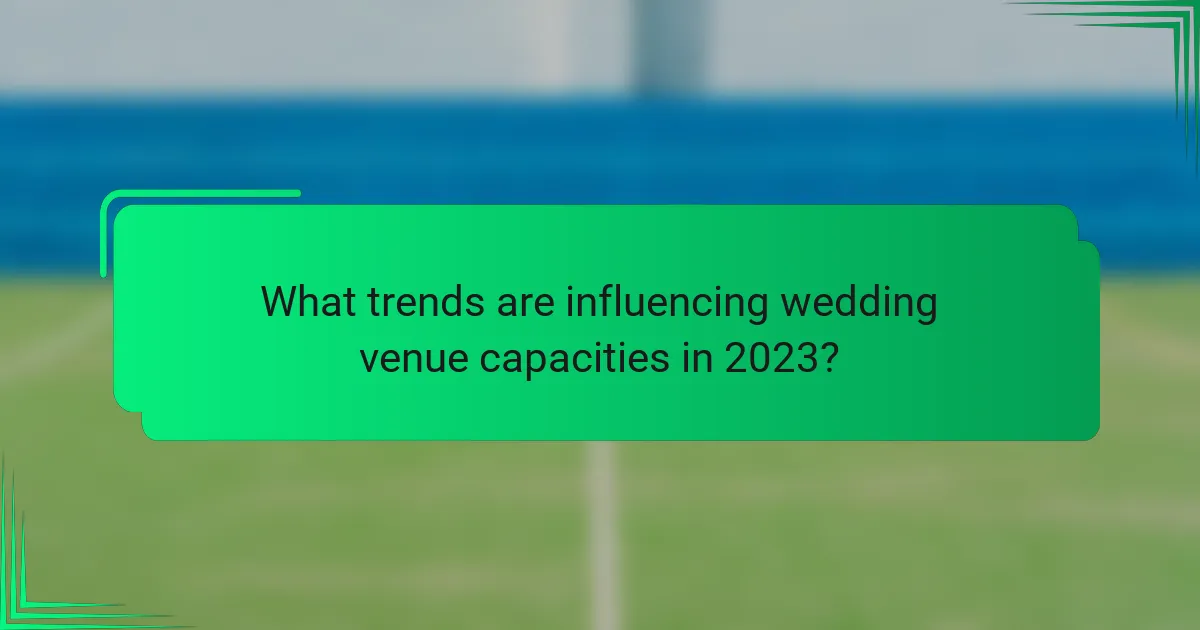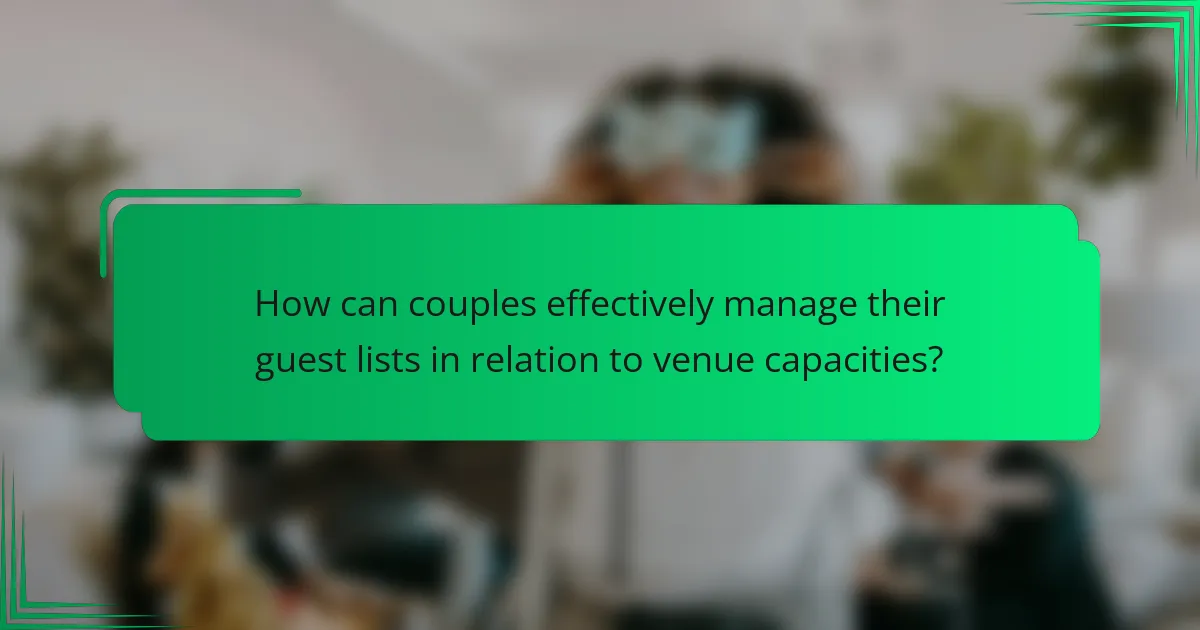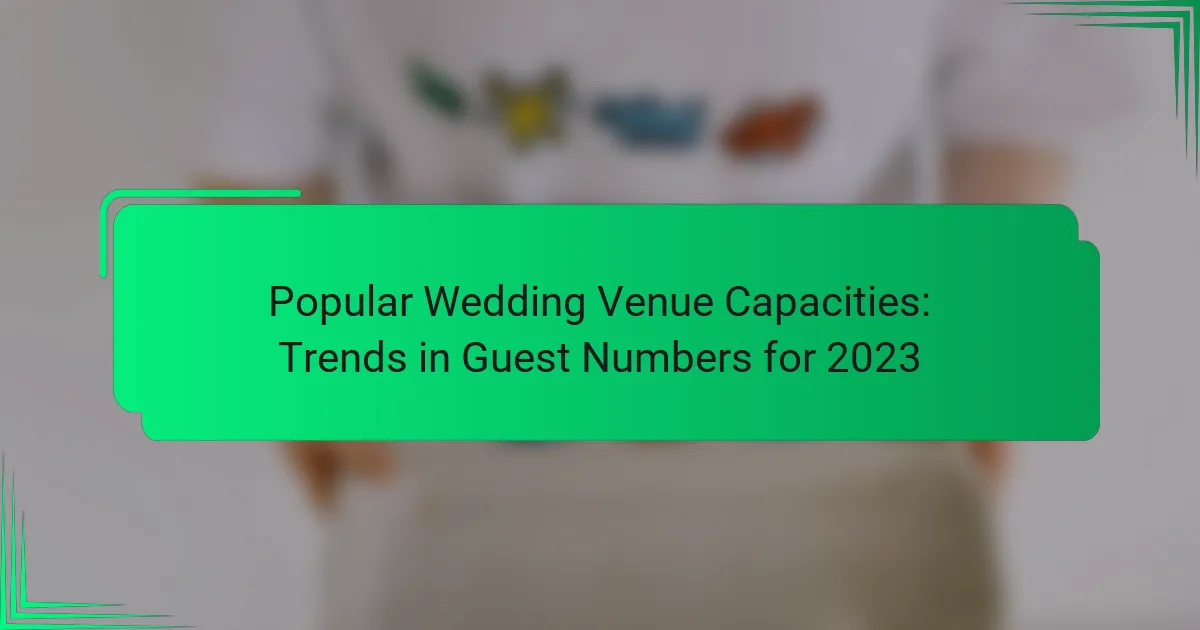Popular wedding venue capacities in 2023 typically range from 50 to 300 guests, reflecting a trend towards smaller, more intimate gatherings. Venues accommodating around 150 guests are preferred for personal celebrations, while larger venues are favored for grander events. The average wedding size has decreased, with many couples opting for 50 to 100 guests, influenced by preferences for meaningful experiences, outdoor settings, and sustainable practices. Effective guest list management is essential, involving clear communication with venues and the use of RSVP tracking tools to maintain alignment with capacity limits. These trends are reshaping wedding planning and venue selection in the current landscape.

What are the popular wedding venue capacities in 2023?
In 2023, popular wedding venue capacities typically range from 100 to 300 guests. Venues accommodating around 150 guests are particularly favored for intimate celebrations. Larger venues that hold 200 to 300 guests are also common for grander events. Smaller venues with a capacity of 50 to 100 guests are preferred for elopements and micro-weddings. These trends reflect a growing preference for personalized experiences. Many couples are choosing venues that align with their vision of a meaningful celebration. The demand for flexible spaces that can adapt to various guest counts is increasing.
How do wedding venue capacities vary across different types of venues?
Wedding venue capacities vary significantly based on the type of venue. Traditional banquet halls typically accommodate 200 to 500 guests. Outdoor venues, like gardens, can host from 50 to 300 guests, depending on space. Churches and religious venues often have capacities ranging from 100 to 600 attendees. Unique venues, such as barns or warehouses, can vary widely, accommodating 100 to 400 guests. Smaller venues, like intimate restaurants, may only cater to 30 to 100 guests. Each venue type’s capacity is influenced by layout, local regulations, and available amenities.
What are the typical capacities for indoor wedding venues?
Typical capacities for indoor wedding venues range from 50 to 300 guests. Smaller venues can accommodate around 50 to 100 guests. Medium-sized venues typically host 100 to 200 guests. Larger venues can cater to 200 to 300 guests. Some venues may even have capacities exceeding 300 guests. These capacities depend on venue layout and local regulations. For example, banquet halls often support larger numbers due to open floor plans. Understanding these capacities helps couples choose suitable venues for their weddings.
What are the typical capacities for outdoor wedding venues?
Typical capacities for outdoor wedding venues range from 50 to 300 guests. Smaller venues often accommodate about 50 to 100 guests. Medium-sized venues typically host 100 to 200 guests. Larger outdoor venues can cater to 200 to 300 guests. These numbers depend on the venue’s layout and available space. For example, a garden venue might have a lower capacity due to seating arrangements. In contrast, a spacious field can support a larger gathering. According to a 2023 wedding industry report, outdoor venues remain popular for their flexibility in accommodating various guest counts.
Why is understanding venue capacity important for wedding planning?
Understanding venue capacity is crucial for wedding planning because it directly impacts guest experience and comfort. Selecting a venue that accommodates the expected number of guests ensures everyone has enough space. Overcrowding can lead to discomfort and safety hazards. Conversely, an oversized venue may feel empty, affecting the atmosphere. Statistically, venues typically have a maximum capacity that should not be exceeded. For instance, a venue with a capacity of 200 guests should not host more than that number to maintain safety regulations. Proper understanding of capacity helps in budgeting and catering decisions as well. It ensures that resources align with the actual guest count, avoiding waste or shortages.
How does venue capacity impact guest experience?
Venue capacity significantly impacts guest experience by influencing comfort and engagement levels. A venue that is too small may lead to overcrowding, causing discomfort and limiting movement. This can detract from social interactions and enjoyment. Conversely, an overly large venue can create a sense of emptiness, making guests feel disconnected.
Research indicates that optimal venue capacity enhances guest satisfaction. For example, a study by the Event Marketing Institute found that events with a well-matched capacity to guest numbers resulted in 30% higher satisfaction ratings. Additionally, appropriate capacity facilitates better service delivery, as staff can attend to guests more effectively. This balance is crucial for creating an enjoyable atmosphere during events such as weddings.
What role does venue capacity play in budget considerations?
Venue capacity significantly impacts budget considerations for events. A larger venue typically incurs higher rental costs. This includes expenses for utilities, staffing, and catering. Smaller venues may offer lower overall costs but could limit guest numbers. Budget constraints often dictate the choice of venue size. Additionally, the venue’s capacity affects catering costs per head. For example, a venue accommodating 200 guests will have different pricing structures than one for 50 guests. Ultimately, aligning venue capacity with budget ensures financial feasibility for the event.

What trends are influencing wedding venue capacities in 2023?
In 2023, trends influencing wedding venue capacities include a shift towards smaller, intimate gatherings. Couples are increasingly prioritizing personal connections over large guest lists. The average wedding size has decreased, with many opting for 50 to 100 guests. This trend reflects a growing preference for meaningful experiences. Additionally, outdoor venues are gaining popularity, allowing for flexible capacity arrangements. Health and safety considerations continue to impact venue choices, encouraging smaller groups. Sustainable practices are also influencing decisions, with couples seeking eco-friendly venues that accommodate fewer guests. These trends are reshaping the landscape of wedding planning in 2023.
How have guest numbers changed in recent years?
Guest numbers have fluctuated in recent years, showing a notable decline during the pandemic. In 2019, average wedding guest counts were around 150 attendees. This number dropped to approximately 70 in 2020 due to COVID-19 restrictions. As restrictions eased in 2021, guest numbers began to rise again, reaching about 100. By 2022, the average guest count increased to approximately 130 as couples adapted to new norms. Recent trends indicate that in 2023, guest numbers are stabilizing around 120 to 150, reflecting a mix of traditional and smaller, more intimate gatherings. These shifts highlight changing preferences in wedding planning and social gatherings.
What factors are driving changes in guest numbers for weddings?
Changes in guest numbers for weddings are driven by evolving social norms, economic factors, and health considerations. Social norms have shifted towards smaller, more intimate gatherings. Many couples now prefer to prioritize close family and friends over large guest lists. Economic factors also play a crucial role. Rising costs of venues and catering can lead couples to reduce guest numbers to stay within budget. Additionally, health considerations stemming from the COVID-19 pandemic have influenced guest limits and safety protocols. Many couples are now more cautious about hosting large events. These factors collectively shape the trends in wedding guest numbers.
How do cultural trends affect guest list sizes?
Cultural trends significantly influence guest list sizes for events. These trends dictate social norms and expectations regarding gatherings. For instance, a rise in intimate weddings has led to smaller guest lists. In contrast, cultural celebrations that emphasize community can increase the number of invitees.
Statistics show that in 2022, 40% of weddings had fewer than 100 guests, reflecting a shift towards smaller ceremonies. Additionally, cultural practices, such as family involvement, can also affect the number of guests. In cultures where large family gatherings are customary, guest lists tend to be larger.
Thus, cultural trends shape the size of guest lists by establishing preferences for intimacy or community engagement.
What are the implications of these trends for venue selection?
The implications of trends in guest numbers for venue selection are significant. Venues must adapt to fluctuating guest capacities. Increasing guest lists may require larger spaces to accommodate all attendees comfortably. Conversely, smaller weddings may lead to a demand for more intimate venues. Flexibility in venue offerings is essential to meet diverse guest number trends. Venues that can provide customizable spaces will likely attract more clients. Data shows that 2023 has seen a rise in average guest counts, influencing venue choices. Venues with scalable options will be more competitive in the market.
How can couples choose venues based on current trends?
Couples can choose venues based on current trends by researching popular styles and capacities for 2023. They should consider intimate settings due to a rise in smaller weddings. Data shows that venues accommodating 50 to 100 guests are increasingly favored. Couples can explore outdoor venues, which have gained popularity for their aesthetic appeal. Social media platforms highlight trending locations and decor ideas. Engaging with wedding planners can provide insights into the latest venue options. Couples should also review online reviews and ratings to assess venue quality. Finally, attending wedding expos can expose couples to current trends and available venues.
What should couples consider regarding capacity limits?
Couples should consider the maximum capacity of their chosen wedding venue. This capacity impacts guest comfort and safety. Venues often have specific limits based on local regulations. Exceeding these limits can result in fines or penalties. Couples should also account for their guest list size when selecting a venue. A mismatch can lead to overcrowding or underutilization of space. Additionally, couples should consider the layout of the venue. The arrangement can affect how many guests can comfortably fit. Understanding these factors ensures a successful and enjoyable event.

How can couples effectively manage their guest lists in relation to venue capacities?
Couples can effectively manage their guest lists by clearly understanding their venue’s capacity. They should obtain the maximum guest count allowed by the venue. This information is crucial for planning. Couples can categorize their guests into must-invite, preferred, and optional lists. This helps prioritize who to invite based on the venue’s limitations.
Using RSVP tracking tools can streamline the process. These tools provide real-time updates on guest confirmations. Couples should also consider potential plus-ones and children when calculating total numbers. This ensures they stay within the venue’s capacity. Regular communication with the venue can help address any changes in guest count.
By following these steps, couples can maintain a manageable guest list that aligns with venue capacities.
What strategies can couples use to optimize their guest lists?
Couples can optimize their guest lists by prioritizing close family and friends first. This ensures that the most important people are included. Next, they should consider venue capacity to avoid overcrowding. Research indicates that venues often have specific limits, which can guide the number of guests. Couples can also create a tiered list, categorizing guests into must-invite, nice-to-invite, and optional categories. This method helps manage the list effectively. Additionally, couples should communicate openly about budget constraints with family. This transparency can lead to a more manageable guest list. Finally, couples can use RSVP tracking tools to monitor responses and adjust the list accordingly. These strategies collectively help in making informed decisions about the guest list.
How can prioritizing guests enhance the wedding experience?
Prioritizing guests enhances the wedding experience by ensuring their comfort and enjoyment. When couples focus on guest needs, it fosters a welcoming atmosphere. This can lead to increased guest satisfaction and positive memories. Providing amenities, such as comfortable seating and food options, caters to diverse preferences. Engaging activities can also keep guests entertained throughout the event. Additionally, personalized touches show appreciation and strengthen relationships. According to a survey by The Knot, 88% of guests feel more valued when their preferences are considered. This highlights the importance of guest prioritization in creating a memorable wedding.
What are the benefits of creating a tiered guest list?
Creating a tiered guest list allows for better management of event capacity and resources. It helps prioritize attendees based on their significance to the event. This organization can enhance the overall experience for both hosts and guests. A tiered list ensures that essential guests receive appropriate attention. It also aids in budget allocation by focusing on key individuals first. This approach can minimize the risk of exceeding venue capacities. Additionally, it facilitates smoother logistics and seating arrangements. Overall, a tiered guest list contributes to a more structured and enjoyable event.
What tips can help couples navigate venue capacity challenges?
Couples can navigate venue capacity challenges by prioritizing their guest list. Start by determining the maximum capacity of the chosen venue. Next, create a tiered guest list, categorizing guests into must-invite, preferred, and optional. This allows for flexibility in case of capacity restrictions. Communicate openly with guests about potential limitations. Consider hosting a virtual option for those who cannot attend in person. Additionally, explore alternative venues with larger capacities if needed. Finally, be prepared to adjust plans based on local regulations or venue policies.
How can couples communicate capacity limits to their guests?
Couples can communicate capacity limits to their guests by clearly stating the maximum number of attendees on invitations. This ensures guests are aware of the venue’s restrictions. Couples can also include a note on the RSVP card to confirm attendance. Additionally, they may send a follow-up message or reminder about the guest limit as the event approaches. This proactive communication minimizes confusion and helps manage expectations. According to event planning experts, clear communication reduces the likelihood of overbooking and ensures compliance with venue guidelines.
What are common mistakes to avoid when selecting a venue based on capacity?
Underestimating guest count is a common mistake when selecting a venue based on capacity. This can lead to overcrowding or discomfort. Overestimating capacity can also result in wasted space and resources. Ignoring venue layout is another mistake; a large room may not accommodate guests comfortably if poorly arranged. Failing to consider additional space for amenities, such as dining and dancing, can impact the overall experience. Not accounting for venue restrictions, like fire codes, can lead to legal issues. Lastly, neglecting to ask about capacity limits during different setups can lead to unexpected challenges.
The main entity of the article is wedding venue capacities in 2023, which are influenced by trends in guest numbers. Popular capacities typically range from 50 to 300 guests, with a notable preference for intimate gatherings of 50 to 100 guests as couples prioritize personalized experiences. The article explores how different venue types—such as banquet halls, outdoor spaces, and unique venues—vary in capacity and the importance of understanding these limits for effective wedding planning. Additionally, it highlights trends affecting guest counts, including economic factors, cultural shifts, and health considerations, providing insights into how couples can navigate venue selection and manage their guest lists effectively.
